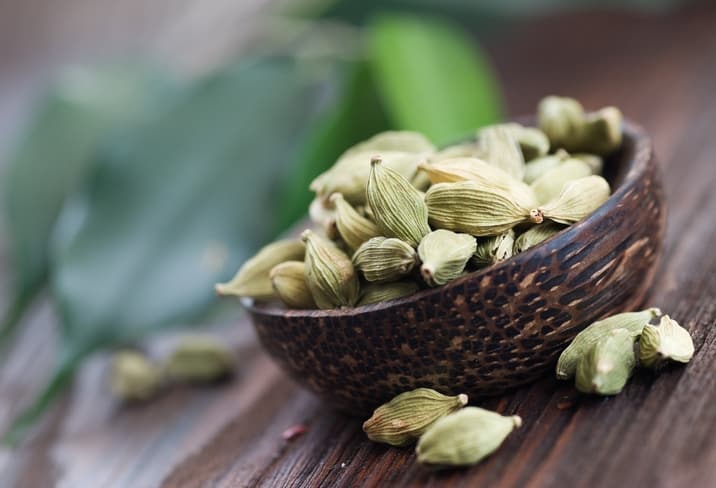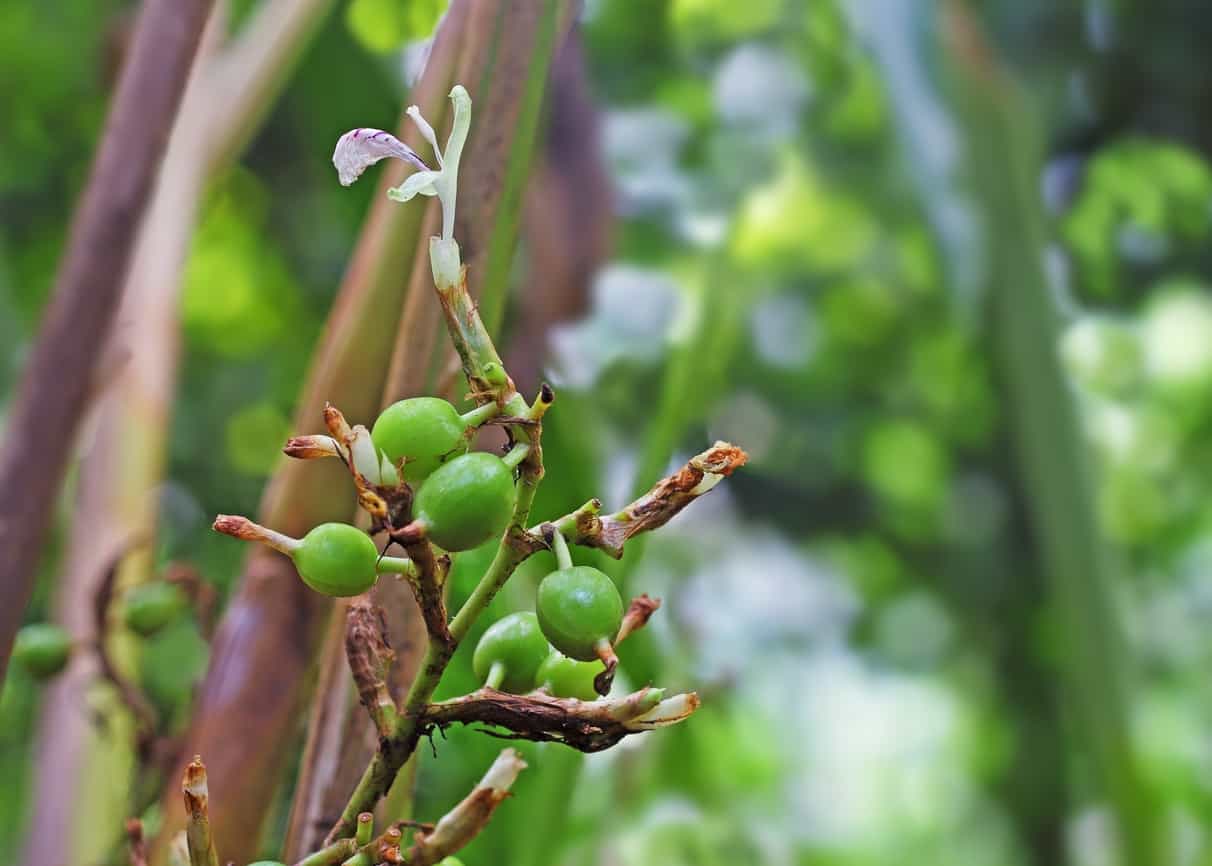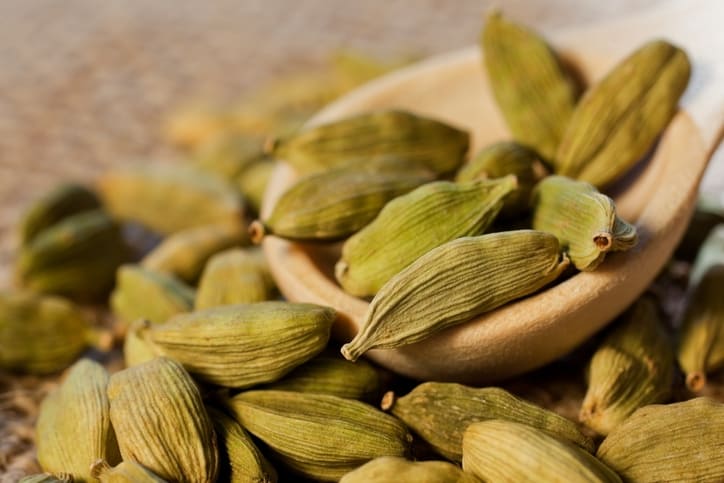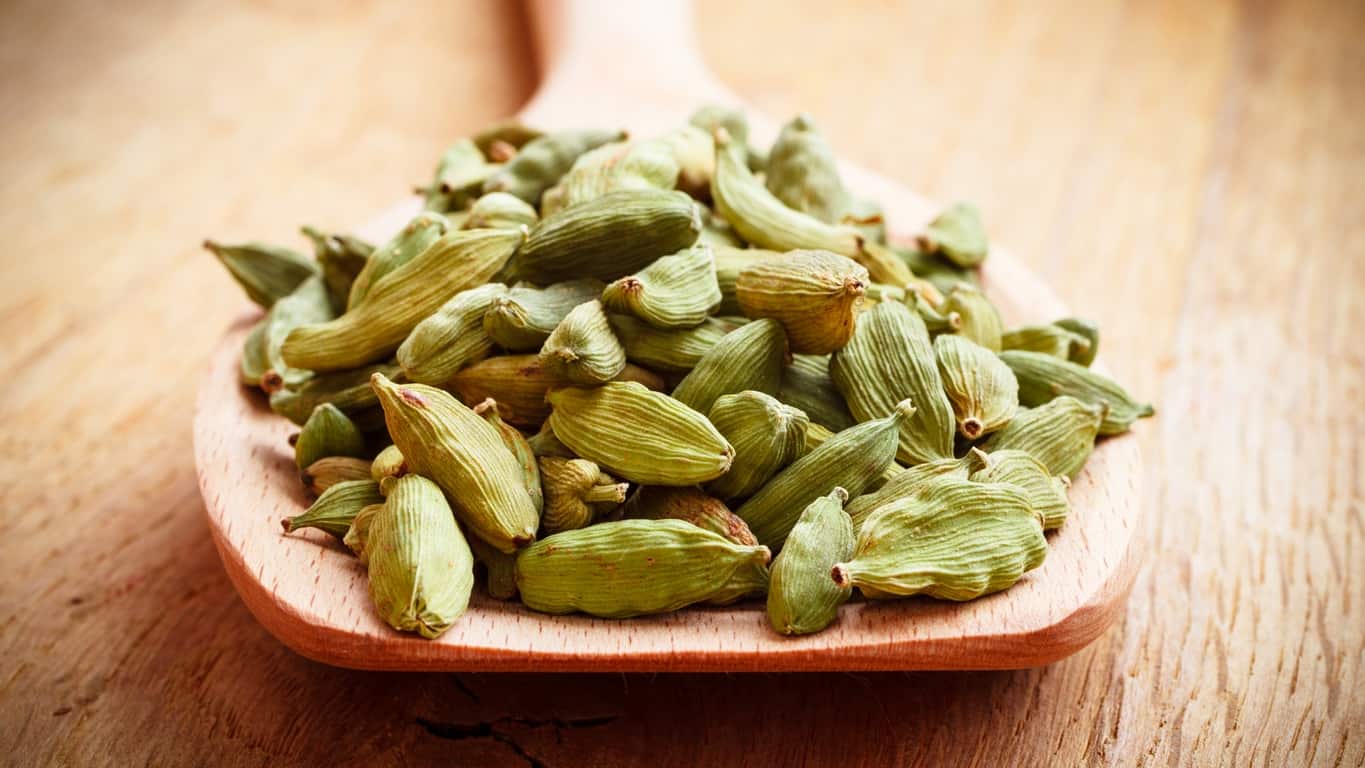Looking to spice up your meals? Cardamom is a fragrant spice that is part of the ginger family that can add excitement to baked goods, add spice to tea, or add flavor to a curry dish.

It’s used around the world in baking and cooking. In fact, some culinary experts have nicknamed it “The Queen of Spices”. Read why this spice should be a staple on your spice rack.
What is cardamom?
Cardamom comes from seed pods of the cardamom plant. It’s in the ginger family and is identified by its trigonal pod husks containing small seeds. Cardamom comes in three primary colors, green (elettaria cardamomum), black (Amomum cardamomum), and white cardamom.

There are slight differences between the varieties, with green cardamom being the more popular variety. Green cardamom uses the whole pod including the seeds. Black cardamom uses only the seeds and is smoke-dried after being harvested, resulting in a distinct slightly smoky flavor. White cardamom is not technically a variety but is green cardamom that has been bleached, which the bleaching process diffuses the rich flavor.
Cardamom plants grow between five and 10 feet tall with leaves up to two feet long. It takes about three years for the plant to mature, which is when the flowers produce the seed pods. Farmers harvest the pods by hand in the fall, which is one reason it has a higher price tag.
The first known use of cardamom was in 1553. Cardamom comes from India, where it grows wild along roadsides and riverbanks. Plus, the versatility of the spice makes it popular in Guatemala, Malaysia, and Tanzania.
Besides being used as a seasoning, cardamom oil is used medicinally to relieve stomach aches and other digestive problems.

What does cardamom taste like?
Each variety of cardamom has a distinct flavor.
- Green cardamom pods have a herbal, citrus, slightly sweet flavor. It’s a good option for both sweet and savory dishes.
- Black cardamom has a stronger flavor. Some describe it as similar to mint, while others describe it as slightly sweet with an earthly, smoky flavor.
- White cardamom is not true cardamom and has very little flavor, making it a less popular option.
How to use cardamom
Since cardamom comes as pods, seeds, or powder, your recipe will guide which type you need. The pods maintain the most amount of flavor, so many dishes will use the entire pod and then discard it before serving. We often add whole cardamom seeds to curries, drinks, or soups.
You don’t need much powdered cardamom to get the intense flavor. It’s also easy to use and measure. A little goes a long way and we often use 1-2 teaspoons in baked good recipes. We can also use powdered cardamom in dry rubs and it is a great addition for grilled meats or poultry.
You can also blend flavors and pair cardamom with other spices. Green cardamom pairs well with saffron, nutmeg, and black pepper. It also plays well with cinnamon and cloves.
Health Benefits of Cardamom
This zesty spice has rich flavors that enhance dishes. It’s also worth exploring cardamom’s health benefits. They have also used cardamom for its medicinal and healing properties.
The USDA Food Data reports cardamom is a source of minerals, including iron, magnesium, selenium, and manganese. Other nutrients cardamom contains are calcium, potassium, and vitamin C.
This plant-based spice may lower cholesterol levels. A study published in Hypertension Journal found a compound called E-cinnamic acid present in cardamom may reduce total cholesterol and low-density lipoprotein, or “bad” cholesterol, while increasing high-density lipoprotein, or “good” cholesterol.
Cardamom is rich in compounds that may help reduce inflammation in the body. Long-term inflammation can lead to chronic diseases and some small studies show there are anti-inflammatory effects from cardamom.
Another study suggested that black pepper and cardamom combined may contribute to immune health.
They conducted most studies with animal participants. We need further research to dig deeper into how cardamom improves human health. As cardamom is a spice, use it sparingly. However, there are few side effects and it is safe for most people.

Substitutes for Cardamom
In a pinch, you can use a few other spices to replace this aromatic spice in recipes. The best replacements for ground cardamom in baking recipes are ones that have similar smells and flavors, such as cinnamon, ginger, nutmeg, allspice, or a combination of these cardamom substitutes.
Ginger is a relative plant of cardamom, so it serves as a good swap. Another suitable substitute is allspice, which is made from dried berries of the tropical Pimenta dioica tree. It has warm, smoky undertones and is available whole or ground.
If you’re lacking cardamom for baking recipes, combine ground cinnamon, nutmeg, and allspice. It may take some trial and error to find the exact amount that works for your dish. Start with equal amounts of each spice.
Get Your Dose of Cardamom
Cardamom is a small plant that delivers complex and warm flavors. You can find green cardamom in the spice aisle of most grocery stores, while black cardamom may be more readily available at international specialty grocers or the international aisle.
If you’ve got a curry recipe, it’s a perfect addition to add depth. Or spice up your rice dish with cardamom to add richness to a healthy grain. I love using cardamom in sweet dishes and in a cup of chai latte.

Leave a Reply